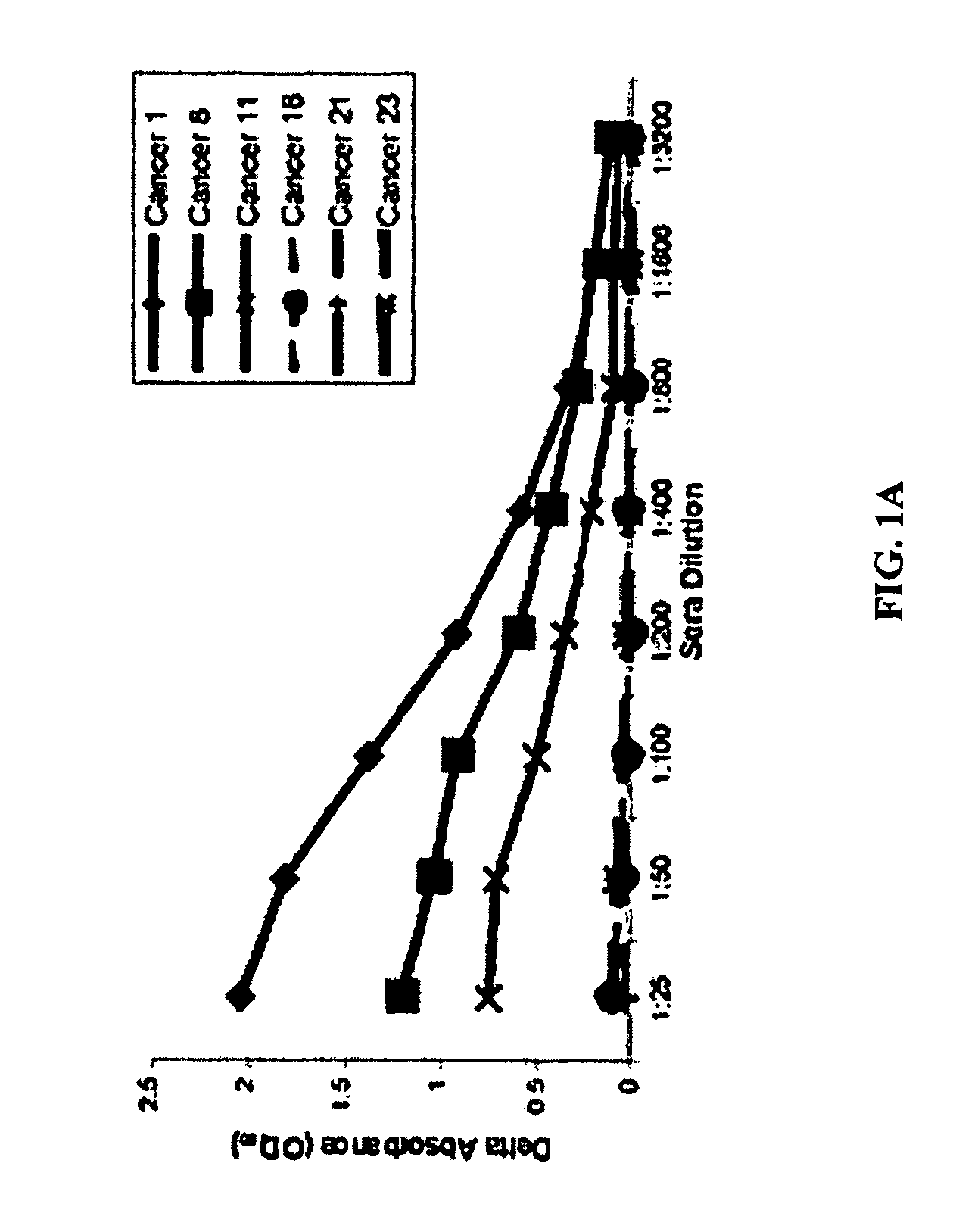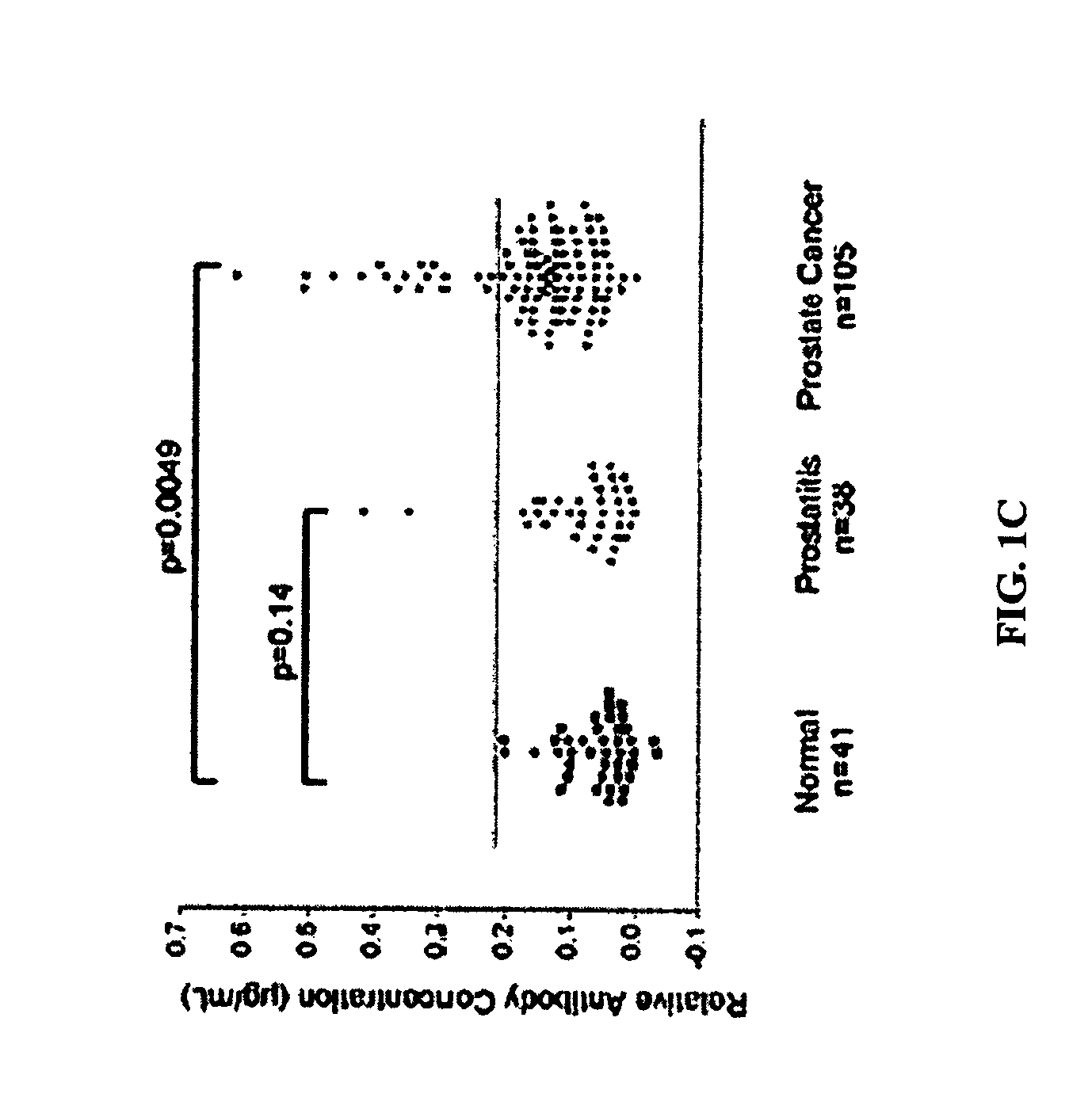Prostate cancer vaccine
a prostate cancer and vaccine technology, applied in the field of prostate cancer vaccines, can solve the problems of no accepted adjuvant treatment for patients undergoing radical prostatectomy or ablative radiation therapy, patients with stage d0 disease are at high risk of progressive disease, and prostate cancer is slow-growing diseas
- Summary
- Abstract
- Description
- Claims
- Application Information
AI Technical Summary
Benefits of technology
Problems solved by technology
Method used
Image
Examples
example 1
Immune Responses to Androgen Receptor Ligand-Binding Domain can Exist in Patients with Prostate Cancer
[0072]We evaluated whether or not patients with prostate cancer have existing immune responses to the androgen receptor (AR). We focused these studies on responses specific for the AR ligand-binding domain (LBD). As shown in FIG. 1, we found that prostate cancer patients, but not healthy male blood donors, have antibodies that are specific for the AR LBD. These antibodies were predominantly of the IgG isotype and IgG2 sub-isotype (data not shown). Moreover, we identified that patients with antibody responses to the AR LBD have CD4+ and CD8+ T cells that proliferate, as well as cells that secrete interferon-gamma (IFNγ), in response to stimulation with the AR LBD (FIG. 2). Antigen-specific IL-10 secretion was observed in many patients who did not have evidence of antibody responses to AR LBD (FIG. 3). Taken together, these results demonstrate that some patients with prostate cancer c...
example 2
Materials and Methods
[0073]Subject Population: Peripheral blood mononuclear cells (PBMC) were obtained from eleven patients with prostate cancer at the University of Wisconsin Hospital and Clinics between 2001 and 2007. All subjects gave Institutional Review Board-approved written informed consent for their blood products to be used for immunological research. PBMC were prepared from heparinized blood by gradient centrifugation.
[0074]T2 Binding Assay: After passing T2 cells into fresh media the day before the assay, these cells were pulsed with 50 μg / mL peptide overnight at 37° C. / 5% CO2. The next day, the levels of HLA-A2 expression on the surface of these cells were measured using a fluorescently-labeled HLA-A2 antibody (Clone BB7.2, BD Biosciences, San Jose, Calif.) followed by flow cytometry using FACSCaliber system (BD Biosciences). The reported “fold change” in fluorescence intensity was calculated by averaging the mean fluorescent intensity results from triplicate samples and...
example 3
Prophetic
Prostate Cancer Therapy with pTVG-ARLBD DNA Vaccine
[0092]Groups of ten suitable rats or mice such as Copenhagen rats are challenged with a suitable number of prostate cancer cells (e.g., 1×104 Mat-LyLu prostate cancer cells). These rats or mice are then immunized with either the pTVG4 (negative control) or pTVG-ARLBD constructs One example is to immunize the rats or mice at days 2, 9, and 16 after the tumor challenge with 100 μg injected intradermally along with 5 μg rat or mouse GM-CSF as an adjuvant. Suitable schemes with fewer or additional immunizations may be used as alternatives. Optionally, boosts (e.g., on weekly basis) can be provided. Other suitable amounts of DNA or adjuvant can be used, as can different adjuvants (such as Freund's adjuvant) or additional vaccines (such as those targeting prostatic acid phosphatase or the synovial sarcoma X chromosome family of proteins). In addition, other suitable routes of administration may be used (such as intravenously). Tu...
PUM
| Property | Measurement | Unit |
|---|---|---|
| median time | aaaaa | aaaaa |
| volume | aaaaa | aaaaa |
| volume | aaaaa | aaaaa |
Abstract
Description
Claims
Application Information
 Login to View More
Login to View More - R&D
- Intellectual Property
- Life Sciences
- Materials
- Tech Scout
- Unparalleled Data Quality
- Higher Quality Content
- 60% Fewer Hallucinations
Browse by: Latest US Patents, China's latest patents, Technical Efficacy Thesaurus, Application Domain, Technology Topic, Popular Technical Reports.
© 2025 PatSnap. All rights reserved.Legal|Privacy policy|Modern Slavery Act Transparency Statement|Sitemap|About US| Contact US: help@patsnap.com



